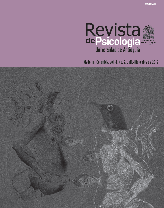Funcionamiento ejecutivo en policonsumidores de sustancias psicoactivas
DOI:
https://doi.org/10.17533/udea.rp.15480Palabras clave:
Desempeño cognoscitivo, Flexibilidad mental, Funciones ejecutivas, Policonsumo, Sustancias psicoactivasResumen
El presente artículo da cuenta de un estudio realizado por psicólogos de la Universidad Manuela Beltrán de la ciudad de Bogotá sobre las alteraciones en funciones ejecutivas en policonsumidores de sustancias psicoactivas (SPA). Se usó como técnica la aplicación de pruebas neuropsicológicas a dos grupos de sujetos -policonsumidores y controles-, para establecer la comparación en el desempeño en tareas de funcionamiento ejecutivo; los resultados evidencian la relación entre el consumo prolongado de diferentes sustancias psicoactivas y el bajo desempeño en las funciones ejecutivas, relación que en cuanto al tratamiento para estos pacientes, implica la necesidad de incluir la rehabilitación neuropsicológica, con miras a reducir los déficits ejecutivos producto del consumo.
Descargas
Citas
Bausela, E., & Santos, L. (2006). Utilidad del Stroop en la psicologíaClínica. Revista Virtual Inter-nacional 5 (1).
Baddeley, A. D. (1997). Human Memory: Theory and practice. Hove: Psycology Press. DOI: https://doi.org/10.3109/09593989709036469
Castellano, L. B. (2006). Las Torres de hanoi y el man-dato de Brahma. Sigma 28, 83 - 94.
Dante, C. (2006). Patrón de toma de decisiones desven-tajosas en pacientes drogodependientes. Salud y drogas, 6 (001), 71 - 88. DOI: https://doi.org/10.21134/haaj.v6i1.105
Dehaene, S. (2001).The Cognitive Neuroscience of Consciousness. Amsterdam: ElSevier Science Publishers.
Flórez, J. (2006). Neuropsicología de los lóbulos fronta-les. En J. Flórez, Neuropsicología de los lóbulos frontales, Juárez: Universidad Juárez Autónoma de Tabasco, 35 - 39.
Gobierno Nacional de la República de Colombia, Ministe-rio de la Protección Social (MPS) (2008). Estudio Nacional de consumo de sustancias psicoactivas en Colombia. Bogotá. Dirección Nacional de Estupefacientes.
Goldberg, E. (2009). El cerebro ejecutivo, lóbulos frontales y mente civilizada. Barcelona: Crítica
Landa, N., Fernández, J., López, J. y Lorea, I. (2006). Comorbilidad psicopatológica en el alcoholismo: un estudio descriptivo. International Journal of Clinical and Health Psychology, 6 (2), 253-269.
Lezak, M. (2004). Neuropsychological assessment. Oxford: Oxford University Press.
López, M. (1998). Evaluación Neuropsicológica: Principios y métodos. Caracas: Universidad Central de Venezuela, 112 - 114.
Quintana, C., Jaimovich, R., & cols. (2010). Cuantifi-cación paramétrica de los cambios en la perfu-sión cerebral producidos por abstinencia y con activación neurocognitiva en dependientes de cocaína. Alasbimn Journal Year 12 (47), 1 - 4.
Serrani, D. (2009). Evaluación neuropsicológica de Drogodependientes Duales a alcohol y cocaína en periodo avanzado de abstinencia. Neurop-sicología, Neuropsiquiatría y Neurociencias, 9 (1), 93 - 113.
Tirapu, J., Muñoz, J., Pelegrín, C., &Albéniz, A. (2005). Propuesta de un protocolo para la evaluación de funciones ejecutivas. Revista de Neurología,41, 177 - 186. DOI: https://doi.org/10.33588/rn.4103.2005054
Verdejo, A., Orozco, C., Meersmans, M., Aguilar, F., & Pérez, (2004). Impacto de la gravedad del con-sumo de drogas sobre distintos componentes de la función ejecutiva. Revista de Neurología, 38 (12), 1109 - 1116. DOI: https://doi.org/10.33588/rn.3812.2003592
Verdejo, A., & Pérez, M. (2005). Neuropsicología en el ámbito de las drogodependencias: Evaluación de las funciones ejecutivas. Revista de la Asociación Proyecto Hombre, 53, 39 - 43.
Verdejo-García A, Sánchez-Fernández MM, Alonso-Maroto LM, Fernández-Calderón F, Perales JC, Lozano O, Pérez-García M (2010) Impulsivity and executive functions in polysubstance-using rave attenders. Psychopharmacology 210 (3), 377–392. DOI: https://doi.org/10.1007/s00213-010-1833-8
Wechsler, D. (1997). Manual de aplicación de la Escala de Wechsler de Inteligencia para Adultos III.México D.F.: Manual Moderno.
Descargas
Publicado
Cómo citar
Número
Sección
Licencia
Los textos enviados para evaluación en la Revista de Psicología Universidad de Antioquia, no deben estar publicados previamente, ni aceptados para su publicación futura en otra revista.
Al aceptarse los envíos para la publicación en la Revista, el autor cederá parcialmente sus derechos, conservando su uso no-comercial y el derecho de circulación académica como archivo de acceso libre.
Excepto que se establezca de otra forma, el contenido de esta revista cuenta con una licencia Creative Commons "reconocimiento, no comercial-compartir igual" Colombia 4.0, que puede consultarse aquí.
Para más información revisar las Políticas editoriales.











